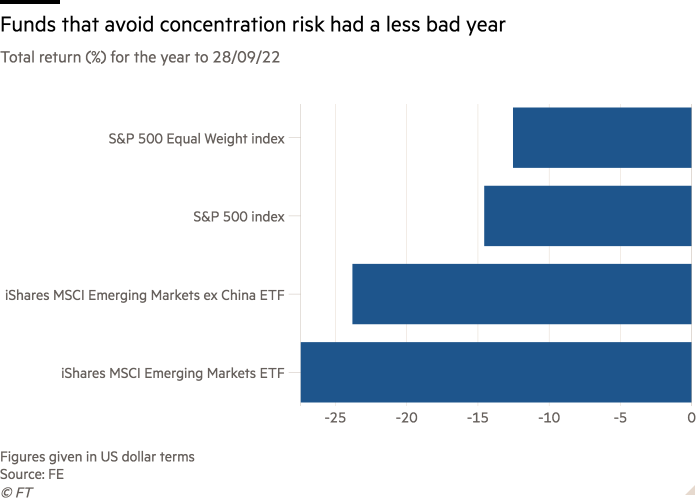Tech stock shocks test concentration risk for ETF investors

Simply sign up to the Exchange traded funds myFT Digest -- delivered directly to your inbox.
Latest news on ETFs
Visit our ETF Hub to find out more and to explore our in-depth data and comparison tools
Stock market falls amid fears of global recession, rising inflation and higher interest rates have made 2022 a miserable year for many investors.
And exchange traded funds skewed towards disruptive, high-growth companies have been particularly hard hit.
Fans of Cathie Wood need no reminding that her flagship Ark Innovation ETF now sits on a paper loss of 64 per cent for the 12 months to 28 September, in US dollar terms. Another growth play, the KraneShares CSI China Internet UCITS ETF, has been heavily exposed to the share price woes of Alibaba and Tencent, pushing it to a loss of 43 per cent for the 12 months to 28 September.
Traditional index tracker funds typically offer much greater diversification than this. However, the difficulties of the past year remind us that even deliberately diffuse funds can still be heavily exposed to a few big, fashionable companies and suffer when sentiment turns against them.
The so-called “Fanmag” stocks — comprising Facebook owner Meta, Amazon, Netflix, Microsoft, Apple and Google owner Alphabet — recently made up more than a fifth of the popular iShares Core S&P 500 UCITS ETF. Trackers of the widely followed MSCI World index also look vulnerable, given its chunky weighting to the US and the recently weakened tech giants.
Meanwhile, funds designed to mitigate such concentration risk are enjoying a revival. ETFs that invest a roughly equal amount into each of the S&P 500’s constituent shares and rely less on tech majors have proved popular. So, too, have emerging market ETFs that exclude the hulking presence of Chinese stocks in indices covering the region. Such funds have performed well for now, though specific risks are worth flagging.
Equally weighted S&P 500 trackers have had something of a resurgence on both sides of the Atlantic. BlackRock launched its iShares S&P 500 Equal Weight UCITS ETF for the European market in August, after rival Invesco launched such a product last year. An Xtrackers fund of the same ilk, launched in 2014, has also amassed significant assets over the years, with more than £3bn across its different forms at the end of August.

In these funds, even the most prominent holdings account for no more than 0.3 per cent of their overall portfolios, so the risks of being dragged down by a sell-off in big tech are substantially reduced. Morningstar fund research analyst Alan Tang notes that tech stocks make up 15 per cent of the equal-weighted S&P 500 index — a big step down from the 27 per cent showing in the market cap-weighted version. Performance data show the equal-weighted approach has certainly been less painful for investors recently.
Concentration worries have prompted new offerings in the emerging market space, too. With China increasingly seen as an investment region in its own right and making up some 32 per cent of the widely followed MSCI Emerging Markets index at the end of August, more funds that track this region but exclude China have appeared.
The Lyxor MSCI Emerging Markets ex China UCITS ETF (EMXC) entered the European market in 2019 and has looked increasingly relevant as Chinese regulatory interventions and lockdown policies have shaken investors. iShares has since launched its own emerging markets ex-China ETF. The chart (above left) shows both funds have fared better than a standard emerging market tracker lately.
An equally weighted US equity fund may also appear slightly more defensive but comes with risks of its own. As Tang notes, by reducing exposure to the tech majors, investors “will likely be switching one investment bias for another”.
“Because equal weight strategies tend to have a bias towards smaller companies, which have historically exhibited higher volatility than their larger peers, the portfolio risk may actually increase,” he explains.
Tang notes, for example, that the S&P 500 Equal Weight index suffered a wider range between peak and trough in trading prices than its conventionally weighted market-cap equivalent in both the Covid crash of early 2020 and in 2008.
Equal-weighted funds will also sell names as they rise and buy those as they fall. This means investors can gain by selling down overhyped stocks before they lose their lustre, though they also risk losing upside value should they hold their gains.
In the case of emerging market funds that exclude China, these tend to have their own substantial country biases: the Lyxor fund recently had around a fifth of its assets in India, with a similar allocation to Taiwan.
With China so dominant in emerging market indices, some investors may well see the appeal of holding a dedicated China fund alongside the likes of an ex-China ETF.
But investors might also see pitfalls in avoiding the market leaders — especially in the US.
“Ultimately, the relentless power of the wisdom of crowds has seen cap-weighted strategies outperform most peers over longer periods in most markets,” Tang says.
Comments